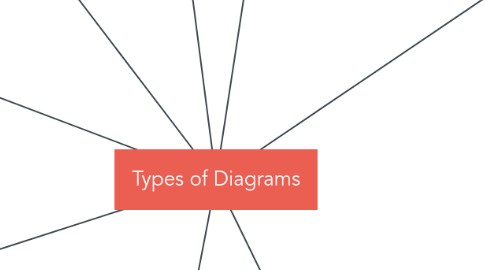
1. Org Chart
1.1. Example
1.2. Short for "Organizational Chart"
1.3. Org chart types
1.3.1. Functional Org Chart
1.3.2. Matrix Org Chart
1.3.3. Hierarchical Org Chart
1.3.4. Flat Org Chart
1.4. Org chart uses
1.4.1. Depicts hierarchies within an organization
1.5. Diagrams related to org carts
1.5.1. Family Tree
1.5.1.1. Visualizes the relationships between family members over multiple generations
1.5.1.2. Related
1.5.1.2.1. Genogram
1.5.2. Organigraph
1.5.2.1. Less linear than org chart
1.5.2.2. Visualizes relationships and opportunities between departments, products or supply chains
2. Flow Chart
2.1. Example
2.2. Flow chart characteristics
2.2.1. Represents an algorithm, process, or workflow
2.2.2. Uses various different shapes to represent steps in a workflow
2.2.3. Uses arrows to visualize flow and sequence
2.3. Main types of flow charts
2.3.1. Document flowchart
2.3.2. System flowchart
2.3.3. Data flowchart
2.3.4. Program flowchart
3. Kanban Board
3.1. Example
3.2. Agile project management tool
3.3. Kanban characteristics
3.3.1. Visualizes tasks within vertical sections on a board
3.3.2. Tasks move from the left-most section on the board to the right-most section
3.3.3. Typical sections: Open - In Progress - Done
3.4. Origin
3.4.1. Toyota, 1940s
3.4.2. Engineering process optimization
3.5. Best Kanban software
3.5.1. MeisterTask
3.6. Special case
3.6.1. Kanban board with swimlanes
4. Fishbone Diagram
4.1. Example
4.2. Also called
4.2.1. Cause–and–Effect Diagram
4.2.2. Ishikawa Diagram
4.3. Identifies different possible causes for an effect or problem
4.4. Fishbone diagram characteristics
4.4.1. Problem is written in a box on the right end of a horizontal line
4.4.2. Potential causes for the problem are written on branches that point from the horizontal line to the top left and bottom left
4.4.3. Result is a kind of fishbone structure
5. Decision Tree
5.1. Example
5.2. Diagram visualizes decisions and outcomes
5.3. Decision tree characteristics
5.3.1. A diagram that has a single element at its base
5.3.2. Multiple elements can branch off from the base, either to the right or towards the bottom
5.3.3. From each element, multiple elements can again branch off
6. Mind Map
6.1. Example
6.2. Developed by English researcher Tony Buzan
6.3. Mind map characteristics
6.3.1. Radial diagram that visualizes relationships and hierarchies of elements around a central idea
6.4. Mind map uses
6.4.1. Brainstorming / Ideation
6.4.2. Note taking and note making
6.4.3. Comprehension and memorization of complex information
6.5. Best mind map software
6.5.1. MindMeister
6.6. Related
6.6.1. Spider Diagram
6.6.1.1. Mind maps are a type of spider diagram
6.6.2. Concept Map
6.6.2.1. Concept maps typically have more than one main topic
7. Timeline
7.1. Example
7.2. Timeline uses
7.2.1. Visualizes a list of events in chronological order
7.2.2. Usually a straight, horizontal line with event dates marked on the line
7.3. Related
7.3.1. Gantt Chart
7.3.1.1. Example
7.3.1.2. Type of timeline used in project management
7.3.1.3. Depicts events and tasks in the form of bars on a time scale
7.3.1.4. Used for tracking project schedules
8. Examples of Specific Diagram Types
8.1. Science Diagrams
8.1.1. Dendrogram
8.1.1.1. Example
8.1.1.2. Type of tree diagram
8.1.1.3. Often shows taxonomic relationships
8.2. Software Design Diagrams
8.2.1. UML Diagrams
8.2.1.1. Example
8.2.1.2. Based on Unified Modeling Language
8.2.1.3. Tries to model and represent software components
8.3. Project Management Diagrams
8.3.1. PERT Charts
8.3.1.1. Example
8.3.1.2. PERT = Program Evaluation Review Technique
8.3.1.2.1. Developed by the U.S. Navy in the 1950s
8.3.1.3. Organizes tasks within a project
8.3.2. Work Breakdown Structure (WBS)
8.3.2.1. Example
8.3.2.2. Breaks a project down into smaller, manageable components or work packages
8.3.2.2.1. "A hierarchical decomposition of the total scope of work to be carried out by the project team to accomplish the project objectives and create the required deliverables."
8.3.2.3. Characteristics of a WBS
8.3.2.3.1. Hierarchical
8.3.2.3.2. Mutually exclusive
8.3.2.3.3. Outcome-focused
